chainsaw lumber cutting guide
Chainsaw lumber cutting is a popular method for efficiently converting logs into usable wood. It offers precision and cost-effectiveness for woodworking projects and sustainable forestry practices. However, it requires proper knowledge and safety precautions to ensure success and prevent accidents.
Why a Chainsaw Lumber Cutting Guide is Essential
A chainsaw lumber cutting guide is crucial for ensuring safety, efficiency, and precision when working with chainsaws. It provides detailed instructions on proper techniques, helping users avoid accidents and improve their cutting skills. The guide also covers maintenance tips, such as sharpening and lubricating the chain, which prolongs the tool’s lifespan. Additionally, it offers insights into sustainable practices, helping users harvest wood responsibly while minimizing environmental impact. By following the guide, operators can achieve professional-grade results consistently.
Overview of Chainsaw Safety and Best Practices
Chainsaw safety and best practices are vital to prevent accidents and ensure efficient cutting. Always wear protective gear, including gloves, safety glasses, and hearing protection. Maintain a firm grip and proper stance to control the saw. Avoid cutting above shoulder height and never touch the chain with bare hands. Regularly inspect and maintain the chainsaw, ensuring the chain is sharp and properly lubricated. Follow guidelines to prevent kickback, and stay alert to surroundings. Proper techniques and precautions ensure safe and effective lumber cutting.
Preparing for Chainsaw Lumber Cutting
Preparing for chainsaw lumber cutting involves selecting the right chainsaw, inspecting its condition, and ensuring proper maintenance. Always wear safety gear and plan your cuts carefully.
Choosing the Right Chainsaw for Lumber Cutting
Selecting the appropriate chainsaw for lumber cutting is crucial for efficiency and safety. Consider the type of wood and cutting frequency. Gas-powered saws are ideal for heavy-duty tasks, while electric saws suffice for smaller projects. Ensure the chainsaw has a bar length of 16-20 inches for optimal lumber cutting. Choose a chain designed for ripping, as it provides straighter, smoother cuts. Additionally, consider horsepower and features like automatic chain lubrication for better performance and durability.
Inspecting Your Chainsaw Before Use
Before using your chainsaw, inspect the chain for sharpness and wear. Check the bar and chain for damage or debris. Ensure proper chain tension and lubrication. Verify that all safety features, such as the chain brake, are functioning correctly. Look for any signs of wear on the guide bar and sprocket. A thorough inspection ensures optimal performance and reduces the risk of accidents, making it a critical step in safe and effective lumber cutting.
Wearing Proper Safety Gear
Wearing proper safety gear is essential when operating a chainsaw. Always use a helmet with a face shield or safety glasses to protect your eyes and head. Durable gloves improve grip and prevent cuts. Wear long sleeves, sturdy pants, and chainsaw chaps to safeguard against accidental cuts. Steel-toed boots provide foot protection, and hearing protection is necessary for loud environments. Ensure all gear fits properly and meets safety standards. Neglecting safety gear increases the risk of serious injury, making it a critical precaution for every cutting task.
Basic Chainsaw Cutting Techniques
Basic chainsaw cutting techniques involve planning your cuts, maintaining proper stance, and grip. Start cuts carefully, apply steady pressure, and adjust as needed. Always maintain control for precise, safe results.
Marking and Measuring the Wood
Accurate marking and measuring are critical for precise chainsaw cuts. Use a pencil to clearly mark the cutting line on the wood, ensuring measurements are exact. Double-check the dimensions to avoid errors. For straight cuts, align the saw blade with the mark, and consider using a guide or template for consistency. Proper measurement prevents waste and ensures the lumber fits your project requirements. Always account for the chain’s thickness when marking to achieve accurate results.
Proper Stance and Grip for Stability
A stable stance and firm grip are essential for safe and controlled chainsaw operation. Stand with feet shoulder-width apart, knees slightly bent, and weight evenly distributed. Hold the front handle with your left hand and the rear handle with your right, maintaining a firm but not overly tight grip. Keep your back straight and the saw close to your body to prevent loss of control. Avoid overreaching, as this can compromise balance and increase the risk of accidents. Proper positioning ensures precision and safety during cuts.
Starting the Cut and Maintaining Control
Start the cut with a steady, gentle touch, applying light pressure and gradually increasing as needed. Keep the chain in contact with the wood, avoiding sudden jerks. Maintain control by holding the saw firmly and keeping your body balanced. Monitor the cut’s progress, ensuring the chain remains engaged and the saw stays on track. Apply the chain brake when pausing or moving to prevent accidental starts. Always be aware of your surroundings to ensure a safe and controlled cutting process.
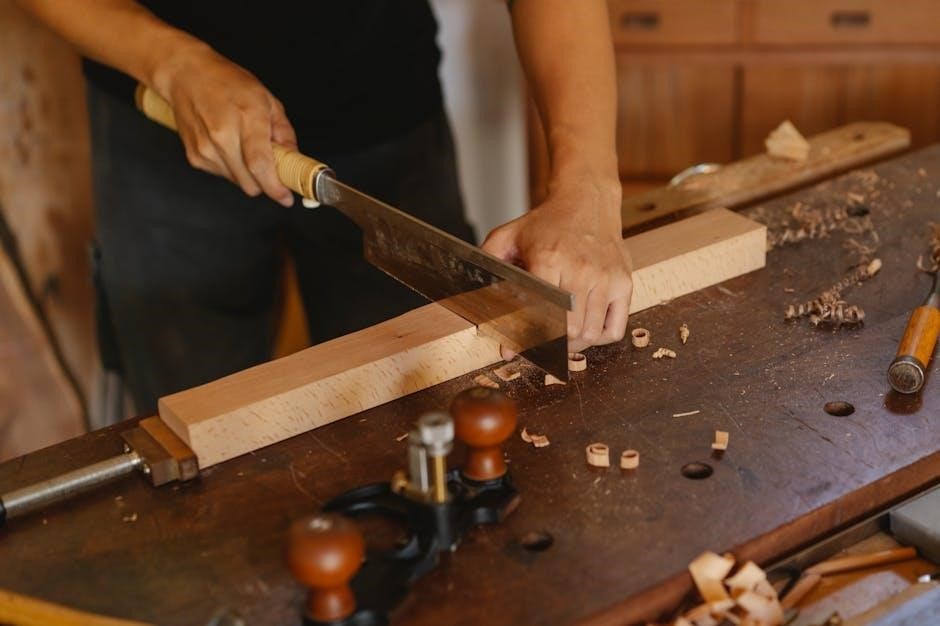
Advanced Chainsaw Lumber Cutting Methods
Advanced techniques involve precision cuts using chainsaw mills for smooth finishes and guiding the saw for straight cuts. These methods enhance efficiency and cut quality, especially for diverse wood types.
Cutting Techniques for Different Wood Types
Cutting techniques vary based on wood type. For hardwoods, use slower, controlled strokes to prevent binding. Softwoods require lighter pressure to avoid splintering. When cutting splintered wood, maintain steady control to minimize kickback. The boring technique is ideal for precise cuts in thick logs, while scoring helps prevent tear-outs. Always match the chain type to the wood density for optimal results and safety. Proper chain lubrication is crucial for smooth cuts in challenging wood conditions.
Using a Chainsaw Mill for Precision Cuts
For precision cuts, attach a chainsaw mill to your tool, ensuring it’s securely fastened. Set up guide rails on the log to maintain straight cuts. Start with a shallow pass to create a reference groove, then gradually deepen the cut. Use wedges to prevent the log from binding the saw. Regularly sharpen and lubricate the chain for smooth operation. This method is ideal for producing straight, uniform planks, especially when processing large or irregularly shaped logs into usable lumber.
Guiding the Saw for Straight and Smooth Cuts
To achieve straight and smooth cuts, use guide rails or clamps to stabilize the saw. Ensure the chain is properly tensioned and well-lubricated for consistent performance. Start with a shallow pass to create a reference groove, then gradually deepen the cut. Maintain steady, controlled movements, avoiding sudden shifts. Use wedges to prevent the log from pinching the saw. Regularly check the chain’s alignment and sharpen it as needed for precise results. This method ensures professional-grade cuts with minimal effort.
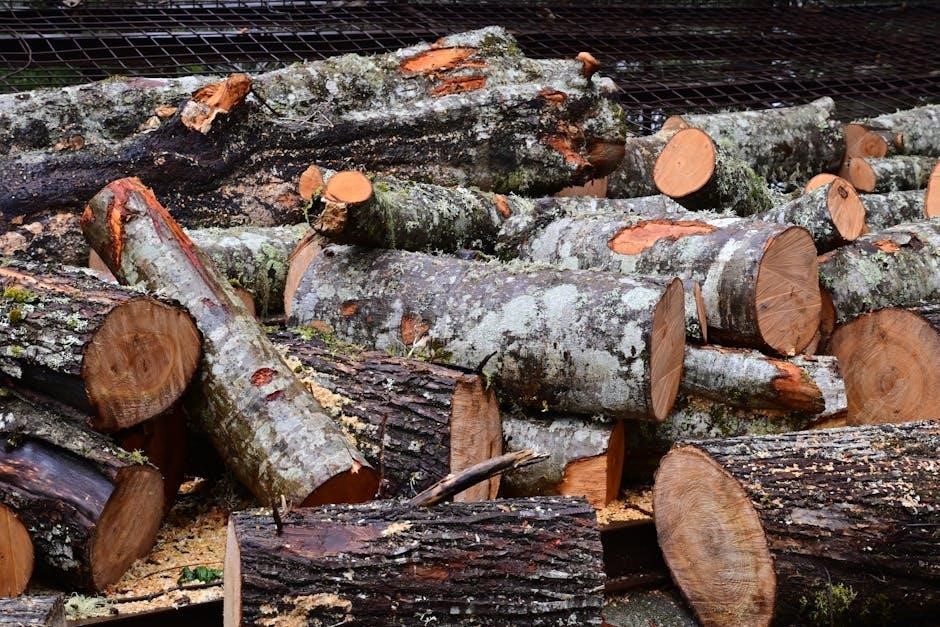
Safety Practices for Chainsaw Operators
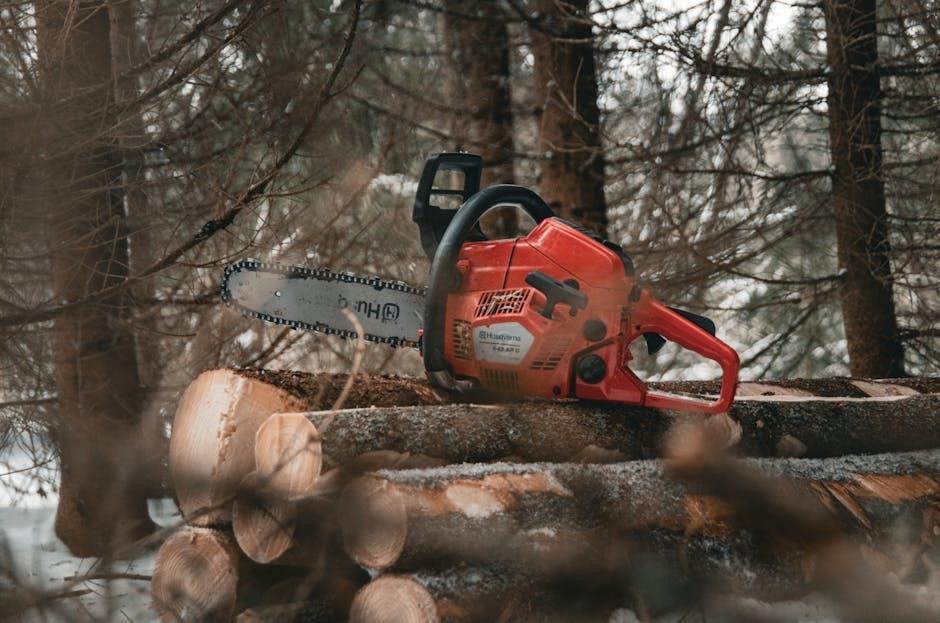
Always wear protective gear, including gloves, safety glasses, and a helmet. Ensure the chainsaw is well-maintained and properly lubricated. Avoid cutting above shoulder height and never reach over the saw. Keep bystanders at a safe distance and be mindful of kickback zones. Regularly inspect the chain for sharpness and tension to prevent accidents during operation.
Avoiding Kickback and Other Hazards
Avoiding kickback is crucial for safe chainsaw operation. Kickback occurs when the saw’s nose contacts a hard object, causing it to swing upward. To prevent this, never cut with the tip of the chain and avoid contact with knots or metal. Keep the chain sharp, as dull chains increase kickback risk. Always maintain control and proper stance. Be cautious of embedded objects like nails or stones, which can cause unexpected hazards. Ensure the workpiece is stable and clear of debris to minimize risks during cutting.
Working in Various Environments
Chainsaw lumber cutting requires adapting to different environments, from forests to urban areas. In dense forests, navigate carefully to avoid obstacles like vines or uneven terrain. In open spaces, ensure a clear work area and watch for bystanders. When cutting in snowy or wet conditions, reduce speed to maintain traction and avoid slipping. Always assess the surroundings for potential hazards, such as power lines or loose debris. Proper planning and awareness are key to safely working in any environment. Use caution and adjust techniques as needed for optimal safety and efficiency.
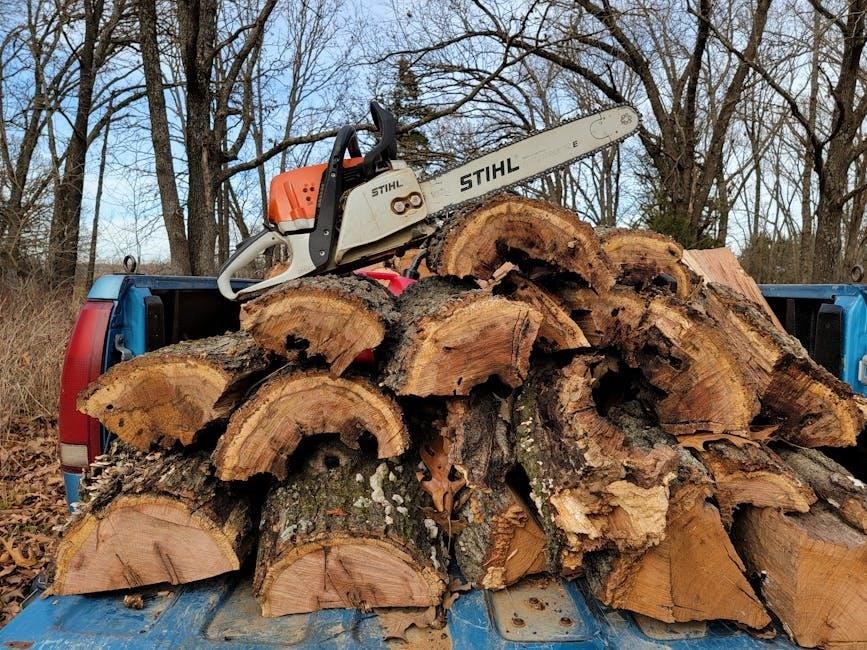
Maintaining Your Chainsaw
Regularly clean the chainsaw, including the chain and bar, to ensure optimal performance. Store the tool in a dry place, using a chain guard for protection. Always inspect the chain and bar for wear or damage before use to maintain efficiency and safety while cutting wood.
Sharpening and Lubricating the Chain
Sharpening the chainsaw chain is crucial for maintaining cutting efficiency and safety. Use a file guide to ensure consistent angles and avoid over-sharpening, which can damage the teeth. Lubricate the chain regularly with high-quality chain oil to reduce friction and prevent overheating. Apply oil before each use and after cleaning. Proper lubrication extends the chain’s lifespan and ensures smooth operation. Regular maintenance ensures the chain runs efficiently and safely, minimizing wear and tear on the entire saw.
Storing the Chainsaw Properly
Store your chainsaw in a dry, secure location, such as a shed or garage, to protect it from moisture and unauthorized access. Always use a chain guard or scabbard to cover the bar and chain when not in use. Apply a light coat of chain oil to prevent rust. Hang the saw to save space and maintain its condition. Regularly inspect the chain for damage or wear before storing. Proper storage extends the lifespan of your chainsaw and ensures it remains ready for its next use.
Common Mistakes to Avoid
Avoid overreaching, cutting above shoulder height, and improper stance, which can lead to loss of control. Always use the correct chain type and maintain sharpness for safe, efficient cuts.
Overreaching and Losing Control
Overreaching is a common mistake that can lead to losing control of the chainsaw. Always cut within your comfortable reach and maintain proper stance to prevent accidents. Cutting above shoulder height or leaning excessively can cause imbalance. Keep both hands firmly on the handles and avoid stretching to make a cut. Losing control increases the risk of kickback or unintended cuts. Use a chainsaw mill or guide for precision and stability, especially for larger logs, to ensure safer and more accurate cuts.
Cutting Above Shoulder Height
Cutting above shoulder height is highly unsafe and increases the risk of accidents. It can lead to loss of control, uneven cuts, and exposure to kickback. Always ensure cuts are made below shoulder height to maintain stability and visibility. If the wood is too high, use a ladder or scaffold for safe access. Proper stance and grip are crucial to prevent accidents. Never compromise safety for convenience, as it can result in serious injury or equipment damage.
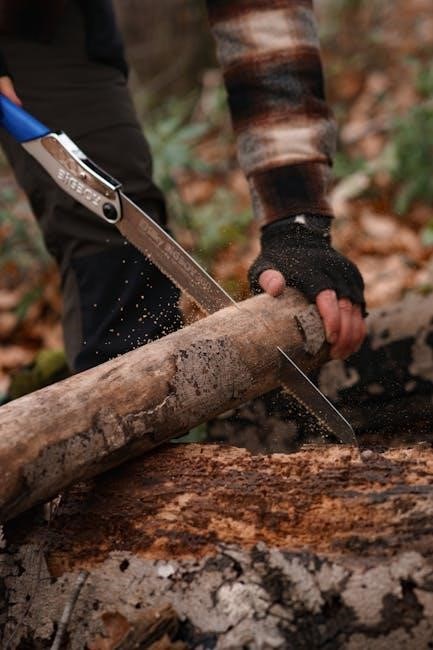
Environmental and Sustainability Considerations
Responsible wood harvesting ensures minimal environmental impact by minimizing waste and promoting sustainable forestry practices. Always consider reforestation and biodiversity when cutting wood, and use eco-friendly equipment and techniques to reduce emissions and preserve natural habitats for future generations.
Responsible Wood Harvesting Practices
Responsible wood harvesting involves planning and executing cuts to minimize environmental impact. Always assess the area to avoid damaging surrounding ecosystems and ensure reforestation efforts follow. Prioritize cutting mature or diseased trees to promote healthy forest regeneration. Avoid clear-cutting and protect biodiversity by preserving habitats. Use eco-friendly equipment and techniques to reduce emissions and waste, ensuring sustainable practices for future generations. Proper planning and execution are key to maintaining ecological balance while meeting lumber needs.